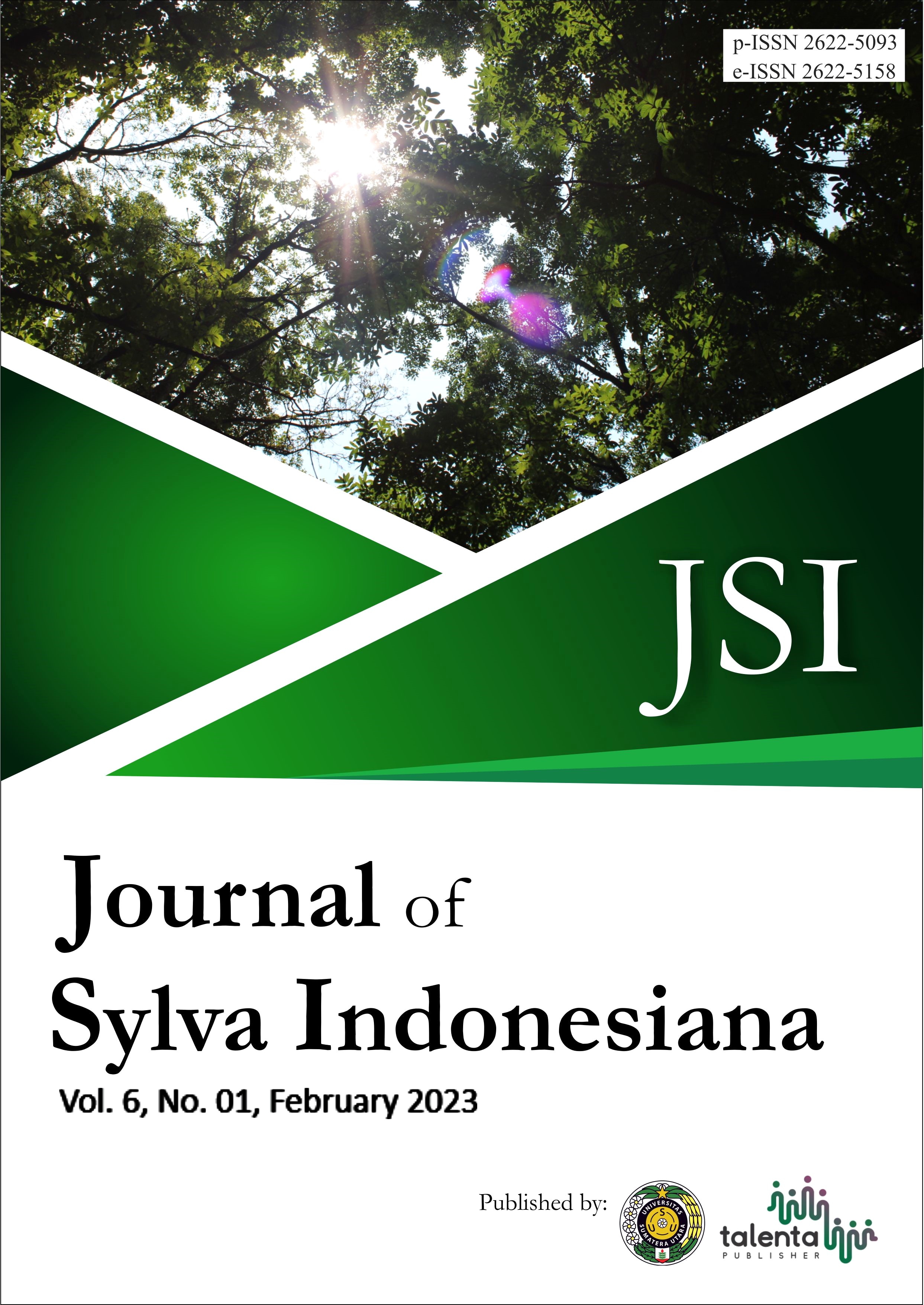Analysis of Sepancong Hill Tourism's Carrying Capacity in the District of Bengkayang
DOI:
https://doi.org/10.32734/jsi.v6i01.8922Keywords:
Campsite, Maximum Number of Tourists, Orchid park, Sepancong HillAbstract
Sepancong Hill is one of the tourist attractions in Bengkayang Regency. According to the survey, there is an increase in tourist visits from day to day. If it continues, it will lead to environmental problems caused by an excessive number of tourists. This research aimed to get the maximum number of tourists according to the carrying capacity of Sepancong Tourism. The method used in this study is to calculate the Physical Carrying Capacity (PCC), Real Carrying Capacity (RCC), and Effective Carrying Capacity (ECC). The analysis used is descriptive quantitative analysis. Sepancong Hill nature tourism is divided into two areas, such as the campsite and Orchid Park. This research showed that the PCC of both areas is 182 and 356, respectively. The RCC of the campsite and orchid park are 51 and 101. The ECC of the camping area and Orchid Park are 51 and 101. The carrying capacity values for both are obtained by the equation PCC > RCC ≥ ECC. The PCC of the whole hill of Sepancong is 352. It means that the carrying capacity of Sepancong Hill is large and can still accommodate tourists with all tourist activities.
Downloads
References
McKercher, B. “Some fundamental truths about tourism: understanding tourism's social and environmental impacts,†Journal of Sustainable Tourism, vol. 1, no. 1, pp. 6-16. 1993.
Butler, R. “Tourism carrying capacity research: a perspective article,†Tourism Review, vol. 75, no. 1, pp. 207-211. 2019.
Hughes, G. “The cultural construction of sustainable tourism,†Tourism Management, vol. 16, no. 1, pp. 49-59. 1995.
Bertocchi, D., Camatti, N., Giove, S., & Borg, J. “Venice and overtourism: Simulating sustainable development scenarios through a tourism carrying capacity model,†Sustainability, vol. 12, p. 512. 2020.
H. Siswantoro, “Kajian daya dukung lingkungan wisata Alam Taman Wisata Alam Grojogan Sewu Kabupaten Karanganyarâ€, Thesis, Universitas Diponegoro, Semarang, 2012.
Manning, R. “Studies in outdoor recreation: Search and research for satisfaction,†Oregon State University Press, 2011.
R.B.P. Sumaraw, G.H. Kapantow, S.G. Jocom. “Analisis daya dukung ekowisata Bukit Doa Mahawu Tomohon di Kecamatan Tomohon Utara Kota Tomohonâ€, Journal of Agribusiness and Rural Development, vol. 1, no. 1, pp. 51-59. 2019.
M.F.R. Herlambang, A.D. Wicaksono, A.R.R.T. “Hidayat, Kemampuan daya dukung wisata Tirta Nirwana Songgoriti,†Thesis, Universitas Brawijaya, Malang, 2016.
Mashayekhan, A., Calichi, M. M., Rassam, G. H., Hoseini, V., Jalilvand, H., & Mohalleh, S. M. M. S. “Recreation Carrying Capacity estimations to support forest park management (case study: Telar Forest Park, Ghaemshahr, Iran),†World Applied Sciences Journal, vol. 29, no. 3, pp. 421–425. 2014.
M. Cifuentes, Determinacion de Capacidad de Carga Truisticaen en Areas Protegidas. Publication Patrocinada Por el Fondo Mundial Para la Naturaleza-WWF. Serie Tecnica Informe Tecnico No.194. Centro Agronomico Tropical de Investigacion Y Ensenaza CATIE, Programa de Manejo Integrado de Recursos Naturales, Costarica, Turrialba, 1992.
T. Aryanto, H. Purnaweni, T.R. Soeprobowati, “Daya dukung jalur pendakian Bukit Raya di Taman Nasional Bukit Baka Raya Kalimantan Barat,†Jurnal Ilmu Lingkungan, vol. 14 no. 2, pp.72-76. 2016.
M.S. Sayan, M. Atik, “Recreation Carrying Capacity Estimates for Protected Areas: Study of Termessos National Park,†Journal of Ecology, vol. 20, no. 78, pp. 66-74. 2011.
A. Sofiyan, GD.Winarno, W. Hidayat, “Analysis of Ecotourism’s Physical, Real and Effective Carrying Capacity in Pulau Pisang, Pesisir Barat Regency,†Jurnal Sylva Lestari, vol. 7, no.2, 2019.
S. Lucyanti, B. Hendrarto, M. Izzati, “Penilaian daya dukung di obyek wisata Bumi Perkemahan Palutungan Taman Nasional Gunung Ciremai Propinsi Jawa Barat,†Thesis, Program Magister ilmu lingkungan, Universitas Diponegoro, 2013.
M.F.R. Herlambang, A.D. Wicaksono, A.R.R.T. Hidayat, “Kemampuan daya dukung wisata Tirta Nirwana Songgoriti,†Thesis, Universitas Brawijaya, Malang, 2016.
E. Sasmita, Darshiharjo, F. Rahmawati, “Analisis daya dukung wisata sebagai upaya mendukung fungsi konservasi dan wisata di Kebun Raya Cibodas kabupaten Cianjur,†Jurnal Manajemen Resort dan Leisure, vol. 11, no. 2, pp. 1-14. 2014.
H. Siswantoro, “Kajian Daya Dukung Lingkungan Wisata Alam Taman Wisata Alam Grojogan Sewu Kabupaten Karanganyar,†Thesis, Program Pasca Sarjana Universitas Diponegoro, Semarang, 2012.
I.G. Pitana, I.K.S. Diarta, Pengantar Ilmu Pariwisata, Andi Sugiyono, Yogyakarta. 2009.
M.S. Sayan, M. Atik, “Recreation carrying capacity estimates for protected areas: study of termessos national park,†Journal Ekoloji, vol. 20 no. 78, pp. 66-74. 2011
M. Suryana, S.R.S. Utomo, “Identifikasi potensi pengembangan pariwisata halal di desa wisata Lebak Muncang Kabupaten Bandung,†Jurnal Ilmiah Pariwisata, vol. 25, no.1, pp. 40-52. 2020.
S. Purwanto, L. Syaufina, A. Gunawan, “Kajian potensi dan daya dukung Wisata Alam Bukit Kelam untuk strategi pengembangan ekowisata,†Jurnal Pengelolaan Sumber Daya Alam dan Lingkungan, vol. 4, no. 2, pp. 119-125. 2014.
L. Mutu’ali, Daya Dukung Lingkungan untuk Perencanaan Pengembangan Wilayah Yogyakarta. Badan Penerbit Fakultas Geografi (BPFG), Universitas Gadjah Mada, Yogyakarta, 2012.

Downloads
Published
How to Cite
Issue
Section
License

This work is licensed under a Creative Commons Attribution-NonCommercial 4.0 International License.


















